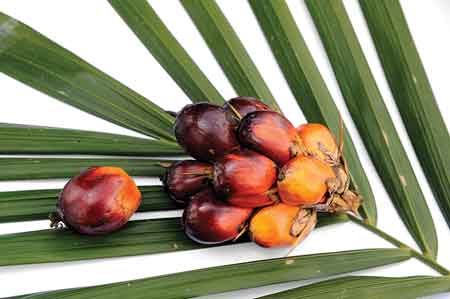Tocotrienols—Variations on the Vitamin E Story
FOOD, MEDICINE & HEALTH
 It seems only yesterday that my friends Gladys Emerson and her husband, Herbert, were part of the team at UC Berkeley that isolated and named a new group of compounds commonly known as tocopherols or simply vitamin E (Evans et al. 1936). Nearly three decades later, the unsaturated analogues of tocopherols, named tocotrienols, were isolated from the rubber plant (Bunyan et al. 1961). Tocotrienols, mostly found in dry annatto seed (~1,400 ppm), barley germ (~910 ppm), palm oil (~730 ppm), rice bran oil (~465 ppm), and wheat germ (~190 ppm), differ in their physical structure and potential health benefits relative to vitamin E.
It seems only yesterday that my friends Gladys Emerson and her husband, Herbert, were part of the team at UC Berkeley that isolated and named a new group of compounds commonly known as tocopherols or simply vitamin E (Evans et al. 1936). Nearly three decades later, the unsaturated analogues of tocopherols, named tocotrienols, were isolated from the rubber plant (Bunyan et al. 1961). Tocotrienols, mostly found in dry annatto seed (~1,400 ppm), barley germ (~910 ppm), palm oil (~730 ppm), rice bran oil (~465 ppm), and wheat germ (~190 ppm), differ in their physical structure and potential health benefits relative to vitamin E.
As most of us know, vitamin E represents a group of lipid soluble compounds. These compounds possess an array of biological functions including but not limited to an antioxidant in the glutathione peroxidase pathway, protection of membranes from oxidation, inhibition of HMG-CoA reductase activity, and blockage of sterol regulatory element-binding proteins (Herrera et al. 2001; Traber et al. 2007). A recent increase in provocative and promising studies of tocotrienols is confounded by studies of vitamin E. However, many of these studies, along with meta-analyses with human subjects have yielded vague or conflicting results. Interestingly, the number of tocotrienols studies represents less than 1% of all research into vitamin E (Sen et al. 2007).
Many popular health statements relative to the potential benefits of tocotrienols have been made over the last decade. Those unofficial statements encompass cholesterol reduction, neuroprotection, radiation countermeasures, and anti-cancer effects in a variety of tissue and tumor types.
The distinction between tocotrienols and tocopherols lies with the molecular tail; tocopherols have a long saturated tail; tocotrienols have a short tail with an unsaturated side chain. The structure of tocotrienols ironically allows them to function in more efficacious ways than the far better-studied tocopherols in that they are able to react more readily with membranes, transport processes, cell signaling, and gene activation (Serbinova et al. 1991; Packer et al. 2001).
There are complicating caveats to consider: a) tocotrienols have a lower bioavailability and are transported differently than tocopherols following oral ingestion (Packer et al. 2001; Fairus et al. 2006); b) since tocotrienols are partially converted to tocopherols in vivo, exceeding some optimal dose of tocotrienols may be counterproductive (Qureshi et al. 2002). Yet it appears that clinical effects of tocotrienols seem to occur at high-dose ranges, such as 200 mg/day to 400 mg/day. More recently, Fu et al. (2014) reported that the bioavailability of tocotrienols was inconsistent as a function of the character of the food matrix and among different target populations—from healthy subjects to smokers to those with illnesses of various types.
A prolific group at the University of Wisconsin (Qureshi et al. 2001, 2015) has demonstrated, both in pigs and in human subjects, that tocotrienols in rice bran oil were effective in reducing LDL cholesterol, serum glucose, and triglycerides in a short time span. Moreover, the effects appeared to be potentiated by concurrent administration of a statin. Justo et al. (2015) essentially replicated the Wisconsin work and further suggested clinical applications in the management of insulin resistance in metabolic syndrome.
Aggarwal et al. (2010) put it well, suggesting that, as disappointment with the therapeutic value of the tocopherols grows, there is exciting potential associated with the tocotrienols, which “await further investigation.” At this time, there are inadequate data on the plasma concentrations of tocotrienols that are sufficient to demonstrate consistent significant physiologic effect and clinically reliable bio-distribution (Ahsan et al. 2014). However, data from in vitro and in vivo models are quite intriguing as a component in the potential management of cardiovascular and neurodegenerative diseases, particularly tocotrienols innate to red palm oil.
As the scientific community would expect, the general caveat that there is no single silver bullet in the face of complex human disease applies to tocotrienols. The task is to define the role of tocotrienols as important components of a balanced and comprehensive approach to health management. Tocotrienols as successor to the tocopherols of vitamin E may represent the paradigm shift we long to see substantiated.
References cited in this column are available from the author.
 Roger Clemens, DrPH, CFS, Contributing Editor,
Roger Clemens, DrPH, CFS, Contributing Editor,
Adjunct Professor, Univ. of Southern California School of Pharmacy,
Los Angeles, Calif. [email protected]
